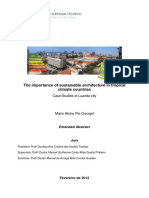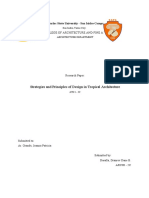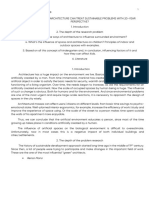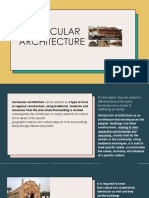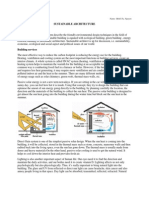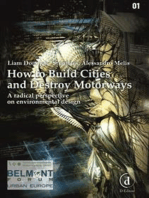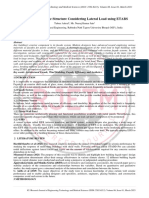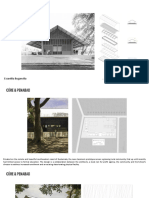1 Social and Environmental Dimensions in Tropical Sustainable Architecture: Introductory Comments
Uploaded by
Walsi Wabarac1 Social and Environmental Dimensions in Tropical Sustainable Architecture: Introductory Comments
Uploaded by
Walsi Wabarac1 SOCIAL AND ENVIRONMENTAL DIMENSIONS
IN TROPICAL SUSTAINABLE ARCHITECTURE:
INTRODUCTORY COMMENTS
Joo-Hwa Bay and Boon-Lay Ong
Department of Architecture, National University of Singapore
Keywords
Architecture, urban design, ethics and poetics, social, environment, design
guidelines, high-rise high-density, tropical, sustainable, ecological.
Why tropical architecture? Critics argue that the term ought not to
exist, and that it is perhaps a misnomer or a faux pas. Can any
architecture built and inhabited in the tropics not be tropical? Some
point out that the phrase, if not the concept, originated during colo-
nial times and is a vestigial legacy of European sovereignty in South
East Asia. Not something to be mentioned in polite company. Then
there is the problem of political boundaries. Many of us practic-
ing in South East Asia forget that tropical architecture applies also
to parts of Australia, Africa and the Americas. On the other hand,
the influence of traditional tropical architecture may be seen in Asia
as far north as India, China and Japan – countries which are largely
not tropical in climate.
This book, resulting from the first conference held by the Inter-
national Network for Tropical Architecture (iNTA) in 2004, does not
provide a simple answer to all these questions. It was not set out to
do so. The conference itself had no lack of interested participants –
garnering over 150 applications from 24 nations. iNTA1 was itself
constituted during this conference and has gone on to be staged in
2006 in Indonesia and thereafter, if all goes well, in Australia also.
2 Tropical Sustainable Architecture
The significance of tropical architecture lies beyond its climatic
and regional concerns. Inasmuch as it confronts the spread of a
homogenous globalism and argues for a locally and environmentally
sensitive approach, it also signals the issues and contentions for a
sustainable future. Indeed, the essays presented in this book are
distinctive not just for their relevance to the tropical nations today
but in their engagement with issues that ought to be of concern
to architects everywhere. To this end, we have carefully selected
presenters from the conference and asked them to write essays
especially for this book2 .
1.1 TROPICAL ARCHITECTURE AND
MODERNISM
One of the impetuses for developing research around tropical archi-
tecture lies in the historical origins of modernism in Europe and
the US. From its early days, modern masters like Le Corbusier
and Oscar Niemeyer understood that Modernism in architecture
ought not to be transplanted globally without some recognition of
its changed context. Alvar Aalto, in championing modernism in the
Scandinavian countries, also emphasized the importance of under-
standing the region, climate and social context. In the US, Frank
Lloyd Wright devised the term Usonian architecture to emphasize
the grounding of his architecture on locality. The Arts and Crafts
movement in the UK too sought their grounding in local traditions
and to preserve their culture.
Unfortunately, much of the work that passes for architecture
in the tropics today are unadulterated transplants from temperate
countries, particularly the US – justified in the name of International
Style. The inappropriateness of such transplants was argued by
many schools of architecture, armed with the writings of environ-
mentalists like Victor Olgyay (1952) with Aladar Olgyay (1963) and
Maxwell Fry (1956) and Jane Drew (1964), and the designs of archi-
tects like Paul Rudolf, Richard Neutra, and several local masters,
many of whom are not known outside the shores of their own
countries (Lefaivre and Tzonis, 2001). The ease with which the Inter-
national Style can be transplanted and the ubiquity and low-cost of
energy as a solution to any environmental woe meant that by and
large, the call for a more appropriate architecture went unheeded
in the tropics – as it was elsewhere.
Countries in the tropical belt have seen unprecedented growth in
the last 50 years and are poised to escalate in terms of economic,
technological and material development. Not only are the issues
facing countries in the tropical belt relevant to other countries, it is
Social and environmental dimensions in tropical sustainable architecture 3
also likely that countries in the tropical belt will be among the lead-
ers in terms of economic and urban development in the world in
the foreseeable future. The fact that the impending escalated devel-
opment in the tropics is unprecedented poses new problems and
challenges to architects and planners all over the world and requires
fresh ideas from our very best thinkers.
1.2 CLIMATE AS DESIGN GENERATOR
The point of departure for most tropical architecture is climate. At
the simplest level, modern tropical architecture has been simply an
adaptation of modern trends in design and construction to climate,
taking into consideration some changes in the lifestyle that the trop-
ical climate affords. Often, there has been an exploration of open
and semi-open spaces, verandas and balconies, and open plans.
But the city and the modern lifestyle it encapsulates do not
encourage such natural living. Strong breezes, so welcome in
the hot humid conditions, mean that paper had to be kept in
place or it might be blown away. Iron rusts, materials deteriorate
and fungi grow faster in the tropics than in temperate countries.
Working indoors, as most city dwellers do, is not comfortable and
productivity is low. Most buildings in the tropical city adopt air-
conditioning as the panacea to all these. The further advantage
of air-conditioning is that, if costs and environmental degradation
are not of concern, the architecture can be entirely stylistic and the
immediate environmental and climatic conditions ignored. For these
two reasons – that it can resolve environmental comfort problems
by simply guzzling more energy resources, and it is stylistically open-
ended – air-conditioned buildings are both popular with the public
and a bane to the responsible architect.
The challenge to define a modern idiom for tropical architecture is
not just a climatic issue but also one that is related to the problem
of adapting to the modern lifestyle, of the transformation of local
cultures to the modern city. While it is possible to retain enough of
the vernacular lifestyle for residential designs to be naturally ven-
tilated, other building typologies like offices and shopping centres
have not been so lucky.
1.3 ETHICS, POETICS, SUSTAINABILITY AND
CONTEMPORARY ARCHITECTURE
Pérez-Gómez (2005), in “Ethics and poetics in architectural edu-
cation”, asserts that the architect has a responsibility to make
4 Tropical Sustainable Architecture
poetic statements of social and cultural conditions with their works.
Science has its limits, and aesthetics is not just the icing on the cake
or an afterthought but an intrinsic responsibility of the architect.
Unfortunately, the ease with which architects can use the
umbrella of the International Style to indulge in form-making can
lead to an “emotivism” (Bess, 1996) in architecture that blithely
ignores all aspects of context, climate, environment and even
human needs. Aesthetics in architecture becomes simply self-
expression and self-referential. To give it its due, emotivism has
given us some very interesting and awe-inspiring architecture –
e.g. the Guggenheim Museum in Bilbao by Frank Gehry or the
Sydney Opera House by Jørn Utzon. Monumentalism and iconism
have their places too.
Architects have to contribute to mankind with their work. The
question is how? Whatever the personal stands of individual contrib-
utors, this book supports Communitarianism. Susan Hagan (2001)
proposes a moral contract between architecture and the environ-
ment. Since the 1970s, many architects, e.g. Tay Kheng Soon and
Ken Yeang in Malaysia and Singapore3 , have criticized the limita-
tions of architects who restrict themselves to the discussion of
‘linguistics’ and ‘styling’ without engaging the volatile environment
and the city.
A common perception is that sustainable environments are not
really “visible,” and “trendy architecture” with seemingly sustain-
able features can fail badly and not work ecologically. Lucius
Burckhardt (1992) comments that ecological architecture, or more
precisely, the ecological house, an issue from the 1970s, has turned
out to be a trap. They appeared well in magazines, won awards, and
were examples to model after, but failed miserably in terms of mea-
surable environmental performance. He suggests that one cannot
really see an ecological building, but one can either build the image
of an ecological house or one can calculate how to save energy and
how to clean up the environment. The problem with the second
option is that nobody will take photographs of it for architectural
publication. Perhaps this problem can be avoided if we can bring
the two dimensions together.
William McDonough (1996) hits out at irresponsible architectural
practices that seek only short-term benefits, and proposes reforms
with a “Declaration of Interdependence” (similar to issues raised
in many fields since the first Earth Day in 1970). He claims that
architects have a special role to play, where design becomes the
foremost statement of human intention. He postulates that the new
role of architects is one of leadership in developing new defini-
tions and measures of prosperity, productivity, and quality of life.
In the “Hannover Principles,” he also proposes criteria for assessing
Social and environmental dimensions in tropical sustainable architecture 5
whether a design solution is safe and just, and operate from the
current solar income.
In contemporary architecture, there is a trend towards the
commercialization of the image that titillates, aggravated by the
internet and the flat screen. Juhani Pallasmaa (1996), in The Eyes of
the Skin, criticized the hegemony of vision in architecture, and pro-
posed more enduring and rich ways to sense and experience the
environment and the place. Pallasmaa (1993) had also suggested
that architecture will pick up on early Functionalism with a social
mission, with better understanding and sophistication, shifting from
the “metaphorical” towards an “ecological-functionalism.” Tzonis
and Lefaivre (1990), in “Critical Regionalism”, traced Mumford’s
position that the modern architect could and should engage a place
and its community critically, using innovation in technology in a
progressive way, thus ensuring continuity as well as change and
growth into the future. Donald Watson (1991, 1995) on rethinking
good architecture, suggests that architecture that embraces sus-
tainability issues of a context is akin to Le Corbusier’s precepts for
an ideal architecture.
1.4 BUILDING SCIENCE AND THE ARCHITECT
Building science is, in many ways, an attempt to reduce envi-
ronmental issues and their spatial dimensions into mathematical
formulas and numbers. Two threads of research can be detected
here. The first deals with physiological studies and is epitomised
by Ole Fanger’s concept of thermal comfort. Such studies are the
bedrock upon which environmentally responsive architecture can be
devised. They can, and often are, legislated as design standards that
provide a much-needed objective framework for architects. While
it is, on the one hand, highly scientific, physiological standards of
comfort do not translate readily into design (Ong, 1994, 1997; Ong
and Hawkes, 1997). They are best utilized as checklists after the
design has been put at least to paper.
As building science becomes more sophisticated and compli-
cated, the danger is that the architect will find it increasingly harder
to incorporate its findings into his work. While building science is
reductionist and precise, in contrast, the architect’s design mind
tends to deal with pre-parametric heuristics, qualitative thinking with
transformations from precedents, allowing him to make quick and
efficient design decisions that synthesize complex criteria besides
including environmental issues (Bay, 2001b). The difficulty in archi-
tectural design is that the architect has to address many diverse
6 Tropical Sustainable Architecture
issues simultaneously during development of his design. The issues
may be isolated, different and even conflicting but the product is a
singular building that responds to all these issues at the same time.
The only way for an architect to function adequately is to internalize
these issues and intuitively resolve them through creative design.
Architects tend to avoid applying building science directly in their
design process, prefering where feasible to work with a building
scientist as a consultant. The typical architect prefers to work with
broad principles and strategies (Hyde, 2000). A survey on the use
of environmental design software among architects showed that
almost none of the architects surveyed employed such tools in
their practice, and that consultations with building scientists are
rare (Wong et al., 1999).
The second thread of research, typified by the Olgyays’ biocli-
matic approach to design, found more followers and inspired later
generations of architects like Ken Yeang and Tay Kheng Soon.
Olgyay and Olgyay (1963), in Design with Climate: Bioclimatic
Approach to Architectural Regionalism, stated that architects do not
have the time and mental resource to compute all the bioclimatic
data. They propose that calculations on how parametric variations in
building form can affect indoor human comfort in a climatic context
be made separate from the architect’s design process, to produce
principles and graphical guidelines for the architects to use as a
generator towards a regionalized architectural language.
Over the years, these parametric studies have grown and have
become more sophisticated with attempts at integrating the differ-
ent fields in building science and addressing other environmental
and sustainable issues.
1.4.1 Social and cultural dimensions
One challenge for building science is the influence of social and
cultural dimensions in the application of building studies into archi-
tectural design. Over the years, social and cultural rituals have
evolved to adapt to climatic conditions and vernacular architec-
ture, in particular, embodies some of these adaptations in their
plan and design features (Hawkes, 1996). It is important that these
socio-cultural factors are somehow subsumed or incorporated into
building science studies. While socio-cultural factors are a common
thread in the writings of many architects, such concerns have not
found a suitable quantitative expression. Various essays in this book
observe the sensibility and necessity of such integration, and sug-
gest ways to think about and correlate these seemingly opposed
dimensions.
Social and environmental dimensions in tropical sustainable architecture 7
In “Rethinking Design Methodology for Sustainable Social
Quality” (Chapter 2 of this book), Alexander Tzonis observes that
an emerging movement is drawing attention to the problem of
“sustainable” artificial and natural environment, initially related to
its physical quality, but increasingly associated with social quality
and resulting in new knowledge. He suggests that methods and
architecture theory do not end like movements that rise and fall
and points out that Design Methods and Critical Theory, thought to
have ended, are tools that can enrich design thinking and under-
standing in architecture and urban planning, and especially in this
current direction.
In “The Selective Environment: Environmental Design and Cul-
tural Identity” (Chapter 3), Dean Hawkes provides another perspec-
tive about architecture as it relates to environmental response and
cultural identity. He suggests that “The Selective Environment is
an approach to environmentally responsive architectural design that
seeks to make connections between the technical preoccupations
of architectural science and the necessity, never more urgent than
today, to sustain cultural identity in the face of rapid global techno-
logical change.” He discusses how selective theory facilitates the
connection between historical analysis in architecture and contem-
porary practice and building technology, with particular relations to
comfort and climate, nature and architecture and the environment
and regionalism.
1.4.2 Urban issues
Another great concern is the effect of high-rise high-density
buildings and overcrowding in the rapidly expanding city. While
the air-conditioned high-rise is easily replicated in the tropical city,
the effects of urban canyons and heat entrapment in the city are
different for the tropics. While sunlight is welcome in the temper-
ate city and buildings are set back to allow sunlight to penetrate
to the road level, shade is preferred in the tropics. While snow
and sleet may be a problem in temperate cities, the problem in
the tropics is heavy rain and flooding. While strong gales are better
avoided in colder cities, more wind and ventilation are welcome in
the tropical (and sub-tropical) city. It is only recently that urban stud-
ies have been made to some depth in tropical cities and the findings
are suggestive in terms of the design of the tropical city for the
future.
In “The Ecological Design of Large Buildings and Sites in the
Tropics” (Chapter 4), Ken Yeang suggests an ideal for relat-
ing all built works ecologically to nature and provide a practical
8 Tropical Sustainable Architecture
framework by which one can deal with environmental issues of
large developments within the dense urban context. He states that
“. . . the ecological design ideal involves the holistic and careful
consideration of the use of materials and energy in built systems
and the endeavour, by design, to reduce their undesirable impact
on, and to integrate them with, the natural systems of the locality
over their entire life-cycle.”
There are several other selected essays in this book that cast
light on various environmental issues, policies and guidelines for
the dense and rapidly transforming tropical city, as well as essays
on experimental sustainable projects relating to community and old
city fabrics, and studies on interrelationships of the social and envi-
ronmental conditions for quality of living and towards a more holistic
sustainability. These are introduced briefly below.
1.5 SELECTED ESSAYS
1.5.1 Socio-environmental dimensions in high-rise
high-density living context
Is it possible to have a modern high-rise vernacular architecture?
Can design guidelines for the architect go beyond the bioclimatic
approach to include social dimensions? In “Socio-Environmental
Dimensions: In Tropical Semi-open Spaces of High-rise Housing
in Singapore” (Chapter 5), Joo-Hwa Bay, Na Wang, Qian Liang
and Ping Kong show an example of a high-rise kampong (village)
in Singapore, and discuss a possible framework to understand
the inter-relationships of the socio-environmental dimensions in the
tropical semi-open living space. They also propose a set of guide-
lines for future design that embodies the socio-climatic potentials,
suggesting a step beyond the bioclimatic, presented graphically and
structured for the qualitative and heuristic design thinking of the
architect.
Are the current assessment methods for sustainable built envi-
ronment adequate? Are they limited to building science crite-
ria, lacking consideration for socio-economic aspects relating to
architecture? In “Building Environmental Assessment Methods
from Sustainable Architecture Perspective: An Analysis in the
Singapore Public Housing Context” (Chapter 6), Boon-Lay Ong and
Chi-Nguyen Cam show how socio-economic dimensions can con-
tribute not only towards a more sustainable quality of living, but
also to quantitative environmental performances. They propose that
socio-economic criteria should be developed and integrated with
environmental criteria in the assessments of sustainable housing
developments.
Social and environmental dimensions in tropical sustainable architecture 9
1.5.2 Policies, building and planning guidelines
Another criticism of current sustainable assessment methods is that
they are mostly developed for the colder climatic zones. In “Policy
and Evaluation System for Green Building in Subtropical Taiwan”
(Chapter 7), Hsien-Te Lin discusses an assessment system that is
applicable to the Asian tropical and sub-tropical context. He explains
a green building evaluation system with four evaluation categories,
Ecology, Energy saving, Waste reduction and Health (EEWH), and
nine other environmental indicators, simplified and localized for
Taiwan. This system has been regarded as a standard evaluation
method for Green Buildings by the Ministry of the Interior of Taiwan
since 1999, as a framework for Green Promotion programs and as
a mandatory Green Building policy.
The EEWH system furnishes the outdated building and plan-
ning guidelines with relevant criteria towards more sustainable
development of the city. In Singapore, a similar system has been
developed called Green Marks, but it is yet to be made mandatory
and integrated with the building and planning guidelines.
Q.M. Mahtab-uz-Zaman, Jalal Ahmad, Fuad H. Mallick and A.Q.M.
Abdullah attempt to evaluate the inadequacy of existing building
and planning guidelines with environmental criteria so as to pro-
pose a new set of guidelines that integrates sustainable qualities
in Dhaka. They discuss a proposal for a new set of Floor Area
Ratio (FAR) guidelines in “In Search of a Habitable Urban Space-Built
Ratio: A Case Study of Building and Planning Regulation in Dhaka
City” (Chapter 8). This new FAR guidelines seek to ensure com-
fortable indoor and outdoor environment; create more green areas
to reduce urban heat island effect, as well as more outdoor
space for social activities; create a better ecological balance and
preserve low lying areas for water retention as flood protection
mechanism – all of which collectively has the potentials to enhance
social and environmental qualities of the city.
1.5.3 Urban environmental impacts
In the tropical regions, it is important to provide natural outdoor
conditions that are conducive to social activities in the urban con-
text, in terms of adequate daylighting, shading from solar radiation
and ample ventilation. A cooler and brighter external environment
will also contribute to the quality of the interior environment of
individual buildings. In “Designing High Density Cities: Paramet-
ric Studies of Urban Morphologies and Their Implied Environmental
Performance” (Chapter 9) Edward Ng, Tak-Yan Chan, Vicky Cheng,
Nyuk Hien Wong and Meiqi Han discuss how varying the skylines of
10 Tropical Sustainable Architecture
tall buildings in the very dense-built environment of Singapore and
Hong Kong can improve performances of daylighting and natural
ventilation in the outdoor spaces. The performances are signifi-
cantly higher as compared to having buildings with uniform height,
and warrant some rethinking of the typical simple height zoning
in master planning.
Excessive heat in the urban environment can have serious neg-
ative impacts on urban dwellers resulting in heat-stress and higher
energy usage because of the need for air-conditioning. Outdoor
activities can be uncomfortable, and air-conditioning can further
increase the heat quantum, escalating the problem, as well as
increasing pollution. Heat sources in the urban context includes
heat re-radiated from building materials exposed to the sun, heat
generated from combustion processes, air-conditioning, and green-
house effect owing to pollutants in the atmosphere. In “Exploring
the Urban Heat Island Effect in Singapore” (Chapter 10), Nyuk-Hien
Wong and Yu Chen discuss their research on the severity of Urban
Heat Island (UHI) effect on the urban environment of Singapore,
and offers suggestion for mitigating some of the impacts.
In “Thermal Environment Study of Urban Canyons” (Chapter 11),
Elias Salleh observes that urban outdoor spaces (urban canyons) in
between buildings of differing heights exhibit different microclimatic
conditions that can affect the conduciveness for social activities.
Generally, a deeper urban canyon provides more shade from solar
radiation and is comfortable with lower wind speeds, compared
to a shallower canyon. He offers several guidelines to designing
urban canyons, by studying empirical examples in Kuala Lumpur,
Malaysia. His study can also inform the environmental assessments
of existing city fabrics, especially the older city fabrics, for various
planning decisions for conservation and renewal.
1.5.4 Experimental sustainable projects
Often old city fabrics exist in many cities, requiring decisions
of reuse or redevelopment owing to environmental problem heat
and pollution owing to intensification of urban activity and com-
mercial pressures. In “Tropical and Traditional: Inventing a New
Housing Model for the Old 36 Street Quarter in Hanoi, Vietnam”
(Chapter 12), Shoichi Ota discusses how conducive environmen-
tal quality can be achieved for a very long and deep lot in the old
city fabric with a modern experimental infill residential structure. He
discusses the concept of “space block” by the architect, Kazuhiro
Kojima, where the modern block structures are composed for max-
imum porosity, and shows the level of success of this project with
Social and environmental dimensions in tropical sustainable architecture 11
an environmental assessment of the thermal comfort level through
maximum ventilation and shading. This experimental example offers
suggestions and hope for architects and planners for the reuse of
historical city fabrics such as this for new uses with confidence that
there will be no slack in the environmental quality.
José Roberto Garcia Chavez discusses a different experimen-
tal dwelling project in “ECOPET 21: An Innovative Sustainable
Building System for Ecological Communities in Tropical Regions”
(Chapter 13). He explains the benefits, principles and the whole
process of an innovative sustainable construction system called
ECOPET 21 for a prototype housing community, integrated with
the application of bioclimatic design principles, sustainable technolo-
gies of renewable energies, and environmental planning. Much can
be learned from this experimental project for thinking about future
sustainable community housing developments.
1.6 TOWARDS TROPICAL SUSTAINABLE
ARCHITECTURE
The essays here define various dimensions and present the latest
research and thinking that surrounds the field of tropical architecture
today. However, the issues presented here are relevant to the archi-
tectural discourse elsewhere in the world also. Frank Lloyd Wright is
known to have said that his buildings are not of any style but simply
designed with style. Style in this sense is not a visual appearance
but a consequence of a particular way of looking at design or of the
design process.
It seems logical to expect that the approach to architecture pre-
sented here will naturally lead to a tropical sustainable architecture,
but however the problematic of tropical architecture language dis-
cussed in the introduction still lingers on and continues to be
debated. We end this book with a philosophical discussion in the
last chapter, presented by Anoma Pieris in “Is Sustainability Sustain-
able? Interrogating the Tropical Paradigm in Asian Architecture”.
We hope that this book will spur deeper reflections and more
research into the issues of tropical sustainable architecture that
engages both the environmental and social dimensions.
NOTES
1 iNTA aims at promoting international research and collaboration
on studies relating to sustainable architecture and urban design,
relating both the social and the environmental dimensions, in the
12 Tropical Sustainable Architecture
tropical and sub-tropical regions. The iNTA website is currently
located at: http://www.arch.nus.edu.sg/inta/index.htm
2 The essays in this book are different from the related papers
in the published proceedings of iNTA 2004 Conference hosted
by the National University of Singapore.
3 These two architects, as do many other architects in Singapore
and Malaysia, work in both countries because of their close
physical, political, social and cultural ties.
REFERENCES
Banham, R. (1984) The Architecture of the Well-tempered Envi-
ronment (2nd ed.) Chicago: The University of Chicago Press.
Originally published in 1969.
Bay, J.H. (2001a) Three tropical design paradigms, in Tzonis, A.,
Lefaivre, L. and Stagno, B. (eds), Tropical Architecture: Critical
regionalism in the Age of Globalisation, London: Wiley-Academy,
pp. 229–265.
Bay, J.H. (2001b) Cognitive Biases in Design: The Case of Trop-
ical Architecture. Ph.D. dissertation, The Netherlands: Design
Knowledge System, TUDelft.
Bess, P. (1996) Communitarianism and Emotivism: Two Rival Views
of Ethics and Architecture, in Nesbitt, K. (ed.), Theorizing a
New Agenda for Architecture. Princeton: Princeton Architectural
Press.
Burckhardt, L. (1992) On ecological architecture: A memo, in
Tzonis, A. and Lefaivre, L. (eds), Architecture in Europe: Mem-
ory and Invention since 1968, London: Thames and Hudson,
pp. 42–43.
Fry, M. and Jane, D. (1956) Tropical Architecture in the Humid Zone.
London: Batsford.
Fry, M. and Jane, D. (1964) Tropical Architecture in the Dry and
Humid Zone. London: Batsford.
Hagan, S. (2001) Taking Shape: A New Contract between Architec-
ture and Nature. Architectural Press: Oxford.
Hawkes, D. (1996) The Environmental Tradition: Studies in the
Architecture of Environment. London: E & FN Spon.
Hyde, R. (2000) Climate Responsive Design: A Study of Buildings
in Moderate and Hot Humid Climates, London and New York:
E & FN Spon.
Jacobs, J. (1962) The Death and Life of Great American Cities.
New York: Random House.
Lefaivre, L. and Tzonis, A. (2001) The Suppression and Rethinking of
Regionalism and Tropicalism after 1945, in Tzonis, A., Lefaivre, L.
Social and environmental dimensions in tropical sustainable architecture 13
and Stagno, B. (eds), Tropical Architecture: Critical Regionalism
in the Age of Globalization. Chichester: Wiley Academy.
McDonough, W. (1996) Design, Ecology, Ethics, and the Making
of Things, in Nesbitt, K. (ed.), Theorizing a New Agenda for
Architecture. Princeton: Princeton Architectural Press.
Mumford, L. (1961) A City in History: Its Origins, its Transformations,
and its Prospects. Paperback reprint, 1991. Penguin.
Olgyay, V. and Olgyay, A. (1963) Design with Climate: Bioclimatic
Approach to Architectural Regionalism. Princeton: Princeton
University Press.
Olgyay, V. (1952) Bioclimatic Approach to Architecture, in The Build-
ing Research Advisory Board, 1953, (ed.), Housing and Building
in Hot-humid and Hot-dry Climates. Research conference report
No. 5, Washington, D.C., Building Research Advisory Board,
pp. 13–23.
Ong, B.L. and Hawkes, D.U. (1997) The Sense of Beauty: The
role of Aesthetics in Environmental Control, in D. Clements-
Croome, (ed.), Naturally Ventilated Buildings: Building for the
Senses, the Economy and Society, E & FN Spon: Chapman & Hall,
pp. 1–16.
Ong, B.L. (1997) From Homogeneity to Heterogeneity, in
D. Clements-Croome, (ed.), Naturally Ventilated Buildings: Build-
ing for the Senses, the Economy and Society, E & FN Spon,
Chapman & Hall, pp. 17–34.
Ong, B.L. (1994) Designing for the Individual: A Radical Interpre-
tation of ISO 7730, in Humphrey, M., Sykes, O., Roaf, S.
and Nicol, F. (eds), Standards for Thermal Comfort. London,
Chapman & Hall, pp. 70–77.
Pallasmaa, J. (1993) From Metaphorical to Ecological Functionalism,
The Architectural Review, 193, June.
Pallasmaa, J. (1996) The Eyes of the Skin: Architecture and the
Senses. London: Academy Editions.
Pérez-Gómez, A. (2005) Ethics and Poetics in Architectural
Education. Folio 06: Documents of NUS Architecture. Singapore:
National University of Singapore.
Tzonis, A. and Lefaivre, L. (2001) Tropical Critical Regionalism, in
Tzonis, A., Lefaivre, L. and Stagno, B. (eds), Tropical Architec-
ture: Critical Regionalism in the Age of Globalisation, Prince Claus
Fund for Culture and Development, The Netherlands. London,
Wiley-Academy, pp. 1–13.
Tzonis, A. and Lefaivre, L. (1990) Why Critical Regionalism Today?
in Nesbitt, K. (ed.), Theorizing a New Agenda for Architecture:
An Anthology of Architectural Theory 1965–1995, New York:
Princeton Architectural Press.
14 Tropical Sustainable Architecture
Tzonis, A., Lefaivre, L. and Stagno, B. (eds), Tropical Architecture:
Critical Regionalism in the Age of Globalisation. London: Wiley-
Academy.
Tzonis, A. (1972) Towards a Non-oppressive Environment. Boston:
Boston Press.
Watson, D. (1991) Commentary: Environmental Architecture.
Progressive Architecture 3.91.
Watson, D. (1995) Sustainability: The roots and fruits of a design
paradigm. In ACSA Proceedings 83rd Annual Meeting, (March
1995). Seattle, Washington.
Wong, N.H., Lam, K.P. and Feriadi, H. (1999) The Use of
Performance-based Simulation Tools for Building Design and
Evaluation: A Singapore Perspective. Building and Environment.
Vol. 35, Great Britain: Elsevier Science Ltd., pp. 709–736.
You might also like
- Topographical Stories: Studies in Landscape and ArchitectureFrom EverandTopographical Stories: Studies in Landscape and ArchitectureNo ratings yet
- Sustainable Luxury - The New Singapore House, Solutions For A Livable Future (PDFDrive)No ratings yetSustainable Luxury - The New Singapore House, Solutions For A Livable Future (PDFDrive)391 pages
- Green Architecture (Taschen, 2000) Scan Only (243p)100% (4)Green Architecture (Taschen, 2000) Scan Only (243p)243 pages
- The Sustainable Asian House - Thailand, Malaysia, Singapore, Indonesia, Philippines (PDFDrive)No ratings yetThe Sustainable Asian House - Thailand, Malaysia, Singapore, Indonesia, Philippines (PDFDrive)368 pages
- Ar152 1 A53 Individual Summary Paper Bulacan RD PDFNo ratings yetAr152 1 A53 Individual Summary Paper Bulacan RD PDF3 pages
- Tropical Sustainable Architecture Social and Environmental Dimensions 1st Edition Joo Hwa Bay pdf download100% (1)Tropical Sustainable Architecture Social and Environmental Dimensions 1st Edition Joo Hwa Bay pdf download47 pages
- Tropical Variants of Sustainable ArchitNo ratings yetTropical Variants of Sustainable Archit47 pages
- Sustainable Architecture in Comparison To Iconic or Organic BuildingsNo ratings yetSustainable Architecture in Comparison To Iconic or Organic Buildings10 pages
- Strategies and Principles of Design in Tropical ArchitectureNo ratings yetStrategies and Principles of Design in Tropical Architecture4 pages
- Title 2 - Presentation _20241216_173049_0000No ratings yetTitle 2 - Presentation _20241216_173049_000028 pages
- (Architecture & Design Series) James Wines, Philip Jodidio - Green Architecture - The Art of Architecture in The Age of Ecology-Taschen (2000)100% (1)(Architecture & Design Series) James Wines, Philip Jodidio - Green Architecture - The Art of Architecture in The Age of Ecology-Taschen (2000)243 pages
- The Unsustainability of Sustainable ArchitectureNo ratings yetThe Unsustainability of Sustainable Architecture18 pages
- Cambridge Stage 8 Unit 2.3 Sustainable Architecture100% (1)Cambridge Stage 8 Unit 2.3 Sustainable Architecture8 pages
- Essay - Sofia Kosheleva - How The Current Architecture Can Treat Sustainable Problems With 20-Year PerspectiveNo ratings yetEssay - Sofia Kosheleva - How The Current Architecture Can Treat Sustainable Problems With 20-Year Perspective9 pages
- Tropikal+Modernizm’in+Yerelliği+Ve+Sürdürülebilir+Mimarlık+Tarihi+İçindeki+YeriNo ratings yetTropikal+Modernizm’in+Yerelliği+Ve+Sürdürülebilir+Mimarlık+Tarihi+İçindeki+Yeri17 pages
- Tropical Sustainable Architecture Social and Environmental Dimensions 1st Edition Joo Hwa Bay - The ebook in PDF format is ready for immediate access100% (2)Tropical Sustainable Architecture Social and Environmental Dimensions 1st Edition Joo Hwa Bay - The ebook in PDF format is ready for immediate access42 pages
- DALENCON Renato Migration of Sustainable Construction CorrectedNo ratings yetDALENCON Renato Migration of Sustainable Construction Corrected8 pages
- How to Build Cities and Destroy Motorways: A radical perspective on environmental designFrom EverandHow to Build Cities and Destroy Motorways: A radical perspective on environmental designNo ratings yet
- Office of The Project Manager Daily Activity & Labour ReportNo ratings yetOffice of The Project Manager Daily Activity & Labour Report6 pages
- Task 1 Shophouse Facade in Malaysia: Group MemberNo ratings yetTask 1 Shophouse Facade in Malaysia: Group Member145 pages
- Specifications For Security Guard Cabin For TZ-4100% (2)Specifications For Security Guard Cabin For TZ-41 page
- Lesson1 PREHISTORIC AND EGYPTIAN ARCHITECTURENo ratings yetLesson1 PREHISTORIC AND EGYPTIAN ARCHITECTURE14 pages
- Tensile Bond Strength of Cement Soil MortarNo ratings yetTensile Bond Strength of Cement Soil Mortar10 pages
- Gypsum Boards: Submitted To: Submitted By: Ar. Priya Mathur Iris Singhania Lissu ElizabethNo ratings yetGypsum Boards: Submitted To: Submitted By: Ar. Priya Mathur Iris Singhania Lissu Elizabeth14 pages
- Evaluation and Repair of A Distressed Masonry Veneer Façade: A Case Study of The Litton Reaves Repair ProjectNo ratings yetEvaluation and Repair of A Distressed Masonry Veneer Façade: A Case Study of The Litton Reaves Repair Project11 pages
- 3072 Bohicket RD Orginal Construction Set 2019No ratings yet3072 Bohicket RD Orginal Construction Set 201941 pages
- Analysis of A Facade Structure Considering Lateral Load Using ETABSNo ratings yetAnalysis of A Facade Structure Considering Lateral Load Using ETABS13 pages
- Selection and Usage Guide Standard Steel Doors: RecommendedNo ratings yetSelection and Usage Guide Standard Steel Doors: Recommended4 pages
- Concrete Admixtures: High Performance & SpecialtyNo ratings yetConcrete Admixtures: High Performance & Specialty6 pages










